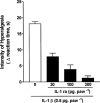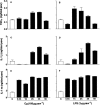Cytokine-mediated inflammatory hyperalgesia limited by interleukin-1 receptor antagonist
- PMID: 10903985
- PMCID: PMC1572194
- DOI: 10.1038/sj.bjp.0703434
Cytokine-mediated inflammatory hyperalgesia limited by interleukin-1 receptor antagonist
Abstract
1. The effect of IL-1ra on response to intraplantar (i.pl.) injection of LPS, carrageenin, bradykinin, TNFalpha, IL-1beta, IL-8, PGE(2) and dopamine was investigated in a model of mechanical hyperalgesia in rats. 2. IL-1ra inhibited hyperalgesic response to LPS, carrageenin, bradykinin, TNFalpha, and IL-1beta, but not responses to IL-8, PGE(2) and dopamine. 3. A sheep anti-rat IL-1ra serum potentiated response to LPS, carrageenin, bradykinin, TNFalpha and IL-1beta but not IL-8. 4. Carrageenin and LPS stimulated and production of immunoreactive TNFalpha, IL-1beta and IL-1ra in the skin of injected paws. 5. The inhibition by IL-1ra of the hyperalgesic response to carrageenin was not affected by antibodies neutralizing IL-4 and IL-10. 6. In mice, IL-1ra inhibited the nociceptive response to i.p. injection of acetic acid. 7. These data suggest that IL-1ra, released at sites of inflammation, limits inflammatory hyperalgesia. This effect is independent of (IL-1ra-induced) IL-4 and IL-10 and appears to be the result of antagonism by IL-1ra of IL-1beta-stimulated eicosanoid production.
Figures






Similar articles
-
Cytokine-mediated inflammatory hyperalgesia limited by interleukin-4.Br J Pharmacol. 1999 Jan;126(1):45-50. doi: 10.1038/sj.bjp.0702266. Br J Pharmacol. 1999. PMID: 10051119 Free PMC article.
-
Cytokine-mediated inflammatory hyperalgesia limited by interleukin-13.Eur Cytokine Netw. 2001 Apr-Jun;12(2):260-7. Eur Cytokine Netw. 2001. PMID: 11399514
-
TNF-alpha and IL-1beta mediate inflammatory hypernociception in mice triggered by B1 but not B2 kinin receptor.Eur J Pharmacol. 2007 Nov 14;573(1-3):221-9. doi: 10.1016/j.ejphar.2007.07.007. Epub 2007 Jul 13. Eur J Pharmacol. 2007. PMID: 17669394
-
Interleukin-1 receptor antagonism.Semin Nephrol. 1996 Nov;16(6):583-90. Semin Nephrol. 1996. PMID: 9125803 Review.
-
Sequential generation of cytokines during the initiative phase of inflammation, with reference to neutrophils.Inflamm Res. 1998 Oct;47 Suppl 3:S137-44. doi: 10.1007/s000110050304. Inflamm Res. 1998. PMID: 9831316 Review.
Cited by
-
Subclinical peripheral neuropathy is a common finding in colorectal cancer patients prior to chemotherapy.Clin Cancer Res. 2012 Jun 1;18(11):3180-7. doi: 10.1158/1078-0432.CCR-12-0205. Epub 2012 Apr 10. Clin Cancer Res. 2012. PMID: 22496202 Free PMC article.
-
[Primary headaches and the influence of inflammatory diseases of the CNS and their respective immunmodulatory therapy].Schmerz. 2007 Oct;21(5):415-23. doi: 10.1007/s00482-006-0520-5. Schmerz. 2007. PMID: 17265016 German.
-
Inhibition of fatty acid amide hydrolase produces PPAR-alpha-mediated analgesia in a rat model of inflammatory pain.Br J Pharmacol. 2008 Dec;155(8):1297-306. doi: 10.1038/bjp.2008.335. Epub 2008 Aug 25. Br J Pharmacol. 2008. PMID: 18724387 Free PMC article.
-
Peripheral Inflammatory Hyperalgesia Depends on P2X7 Receptors in Satellite Glial Cells.Front Physiol. 2020 May 25;11:473. doi: 10.3389/fphys.2020.00473. eCollection 2020. Front Physiol. 2020. PMID: 32523543 Free PMC article.
-
Role of interleukin-1beta during pain and inflammation.Brain Res Rev. 2009 Apr;60(1):57-64. doi: 10.1016/j.brainresrev.2008.12.020. Epub 2008 Dec 31. Brain Res Rev. 2009. PMID: 19166877 Free PMC article. Review.
References
-
- AREND W.P., MALYAK M., GUTHRIDGE C.J., GABAY C. Interleukin-1 receptor antagonist: role in biology. Ann. Rev. Immunol. 1998;16:27–55. - PubMed
MeSH terms
Substances
LinkOut - more resources
Full Text Sources
Molecular Biology Databases

